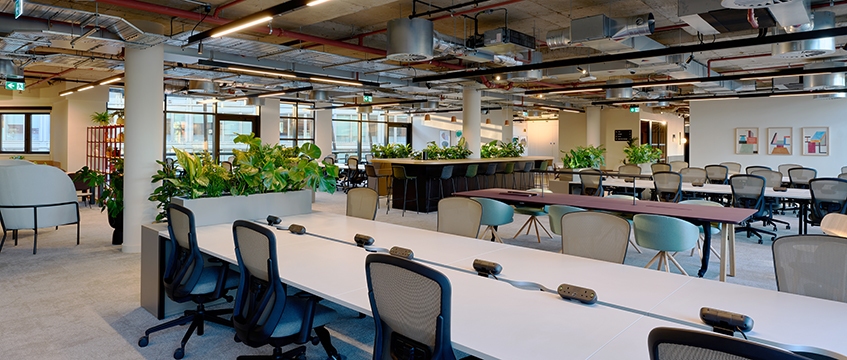Manchester homes under construction jump 30% as Belfast builds flatten
Major UK regional cities have defied economic and political concerns with strong residential-led construction growth.
Residential construction rose considerably in Manchester, Leeds and Birmingham, and remained steady in Belfast. In Manchester, the largest market in the regional reports, there were 14,480 homes under construction in 2018 – up 30% from the year before, according to the latest Deloitte Crane Survey.
With a rise in city centre living meeting a growing desire from students to stay near their universities after graduation, demand for residential development has reached new highs in the regions.
Major UK regional cities have defied economic and political concerns with strong residential-led construction growth.
Residential construction rose considerably in Manchester, Leeds and Birmingham, and remained steady in Belfast. In Manchester, the largest market in the regional reports, there were 14,480 homes under construction in 2018 – up 30% from the year before, according to the latest Deloitte Crane Survey.
With a rise in city centre living meeting a growing desire from students to stay near their universities after graduation, demand for residential development has reached new highs in the regions.
But growth was not limited to residential development as office construction activity grew in all of the cities besides Birmingham.
Office space under construction topped 2m sq ft in Manchester – up 37% year-on-year – while Belfast saw a rise of 35% and Leeds a 10% rise.
Simon Bedford, partner and regional head at Deloitte Real Estate, said: “These regional cities have continued to do very well despite the uncertainty around Brexit. Is that going to continue as the reality of our Brexit deal becomes clear? It’s difficult to say.
“One would think there may be some turbulence in the marketplace over the next couple of years but there is no evidence of that at the moment.”
Activity shows little signs of slowing, with the number of new starts in 2018 at a record high in Manchester (44 new starts, above the previous record of 39 in 2016) and Leeds (21, topping the 16 new starts in 2017). There were 23 new starts in Birmingham, just below 2017 (24) and 2016 (25).
However, Deloitte warned that although activity is at a high and cities have ambitious plans, they will need infrastructure to maintain development. In particular, Bedford said, they have to be “ a lot smarter” about delivering technology.
He added: “They’ve all got innovation labs. They’ve all got areas of the city where they’re thinking of smart solutions, but if you thought about Stockholm or Helsinki, they’ve got a smart strategy for the whole city. I don’t think any of them have really got that yet.”
Manchester
Manchester’s residential pipeline is the largest in the regions at 14,480 homes under construction across Manchester city centre and Salford – more than double the number in 2016.
Close to 6,000 homes will be delivered in Salford, which also saw seven new starts last year.
Completions in 2019 are projected to exceed 5,500 homes before rising to 7,500 in 2020.
As in the other cities, Manchester’s activity is driven by rising city centre living and growing job opportunities as a result of students staying in the area.
New starts reached a record 44, while office space under construction topped 2m sq ft.
Bedford said: “The thing that always surprises me about Manchester is its ability to generate new markets for itself.”
Life sciences and technology will be the biggest drivers of activity in the coming three or four years, he added. The city delivered the Graphene Engineering Innovation Centre last year, while the Henry Royce Institute, a material sciences institute led by the University of Manchester, is expected to complete next year.
Student accommodation development dipped in 2017 but has since rebounded with three schemes totalling 1,794 beds. Demand continues to be high in the sector given the region’s 100,000 students and demand particularly from international students, who make up a quarter of the University of Manchester’s student population.
Deloitte said the city has remained resilient and efforts to “position the city as a go-to location for growth sector occupiers” are showing signs of success.
Belfast
Two years on from the Northern Irish Assembly collapsing, effectively leaving the region without a government, activity is subdued in Belfast. While residential development is soaring in the other three cities, Belfast has just 180 homes under construction with no new starts in 2018.
Despite this, residential development remains a priority in the city as it looks to increase its population by 70,000 by 2035.
A £12m build-to-rent scheme by Lacuna Developments is due to start on site early this year, and plans for more than 400 homes are under way at the former Sirocco Works site as part of a wider masterplan for the Belfast Waterside area that will include 800 homes in total.
Bedford said a lack of decision making was “undoubtedly” having an impact on development, particularly as Belfast needs large infrastructure projects, such as a city centre transport interchange, which have not materialised.
Hotel development, by contrast, had a strong year, with 11 completions totalling 1,249 bedrooms – a massive jump from the 98 completed two years prior. That activity meant there were nearly 25% more hotel rooms available in the city at the end of 2018 than there were in 2017.
Student accommodation similarly reached 2,029 completions last year, up from 156 in 2017, as supply started catching up with demand.
However, the glut of completions means the amount of space still under construction is down 94% for hotels and 12% for student housing, year-on-year. While hotel activity is expected to pick up again given Belfast’s strong tourism industry, led most recently by Game of Thrones, Bedford said he will “wait and see” how much demand there is for student housing.
Though office starts fell from four in 2017 to just two last year, the amount of space more than doubled from 194,787 sq ft to 414,502 sq ft. Among the new starts is the £85m Bedford Square development where Deloitte has agreed to take up to 100,000 sq ft for its Northern Ireland base.
Bedford said: “The critical things for Belfast are to deliver a residential offer if the city is to continue to have cranes on the skyline and also make good on demand for office space that will create jobs in the city.”
Birmingham
Deloitte Crane Survey 2019 Birmingham
A record year for office completions awaits Birmingham this year despite a small fall in activity last year. There were just two new office starts in the city – the lowest since 2014 – and space under construction fell by 2% to 1.4m sq ft.
However, completions are expected to reach 830,000 sq ft this year, compared with 286,000 sq ft in 2018. About a third of total space under construction is prelet, implying continued occupier interest in the city.
Residential development is also reaching record highs in Birmingham, with more than 5,000 homes under construction. Completions are expected to rise to 2,924 in 2019 – up from 1,696 in 2018 and considerably above the 10-year annual average of 555.
Looking ahead, Deloitte said confidence in the city had “surged” over the past three years but that the impact of external factors, such as Brexit, might persuade developers to defer new acquisitions and delay new starts.
Projects such as HS2, leading to the £300m Curzon Street station development, and Lendlease’s £1.5bn, 17-hectare Smithfield development help ensure the city remains active and attractive for occupiers and investors.
Leeds
2018 was a year of records and near-records for Leeds. There was a record 21 new starts, including the most new student housing starts, at four, and student bed space under construction at 2,768 beds.
Office construction hit 804,257 sq ft and completions totalled 560,000 sq ft – more than double the annual average of 265,751 sq ft.
Though not creating a lot of jobs by itself, Channel 4’s decision to open a regional HQ will likely bolster the city’s tech and media credentials, which Bedford said he expected Leeds to capitalise on.
He said: “I would expect the jobs market to flourish over the coming period. That will generate demand from the office and residential sector. The signs for Leeds are very promising.”
Meanwhile, Leeds’ three universities are driving demand from both local and international students for high quality student living, which the market is delivering after years of lower activity.
In the residential market, Leeds has 2,232 homes under construction – topped only by 2007’s 3,839. Five of the seven developments are build-to-rent, totalling 1,397 homes, and mark the first PRS schemes in the city.
To send feedback, e-mail karl.tomusk@egi.co.uk or tweet @karltomusk or @estatesgazette











